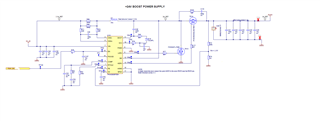Hi TI Team,
We are using TPS43060 in our design with following specs:
| Vin | 10.8V - 15V |
| Vout | 24V |
| Iout | 2A |
| Fsw | 400kHz |
The design does not look incorrect but there are following observations:
1. Board #1: We concluded that the boost IC is damaged due to following impedance checks
| HDRV to gnd | 3.3Ohm |
| LDRV to gnd | 0.5Ohm |
| Vcc to gnd | 1.8Ohm |
| Boot to gnd | 1.8Ohm |
2. Board #2: The drain and source of the low side MOSFET appeared to be short. Initially the board boosted output voltage to Vin+3V but eventually failed.
Both the boards were not subjected to any loading conditions when they were damaged. It was initial programing of the boards with EN being pulled high by the microcontroller.
Schematic snippet

Let me know your thoughts on the design.







